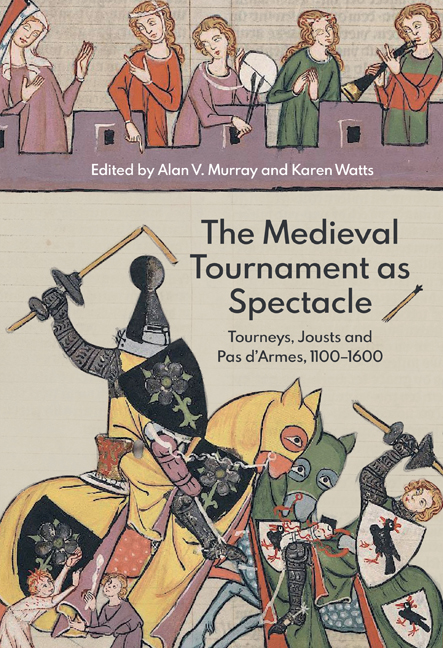Book contents
- Frontmatter
- Contents
- List of Illustrations
- List of Contributors
- Preface and Acknowledgements
- Introduction: From Mass Combat to Field of Cloth of Gold
- Research on the Medieval Tournament (1100–1600): A Select Bibliography
- 1 Now Form Up Close Together! Tactics and Ethos of the Tourney in Early German Sources (Twelfth to Thirteenth Centuries)
- 2 Por pris et por enor: Ideas of Honour as Reflected in the Medieval Tournament
- 3 Richard II of England and the Smithfield Tournament of October 1390: An Instrument to Establish Royal Authority
- 4 Alle myn harneys for the justes: Documents as a Source for Medieval Jousting Armour
- 5 The Tournament Saddle
- 6 Between Sport and Theatre: How Spectacular was the Pas d’armes?
- 7 Art Imitating Life Imitating Art? Representations of the Pas d’armes in Burgundian Prose Romance: The Case of Jehan d’Avennes
- 8 The Foot Combat as Tournament Event: Equipment, Space and Forms
- 9 Power and Pageantry: The Tournament at the Court of Maximilian I
- 10 The Field of Cloth of Gold: Arms, Armour and the Sporting Prowess of King Henry VIII and King Francis I
- Appendix 1 Calendar of the Royal Combats at the Field of Cloth of Gold, June 1520
- Appendix 2 Articles for the Challenge: The Emprise
- Index of Objects
- Index of Manuscripts
- General Index
Appendix 1 - Calendar of the Royal Combats at the Field of Cloth of Gold, June 1520
Published online by Cambridge University Press: 11 September 2020
- Frontmatter
- Contents
- List of Illustrations
- List of Contributors
- Preface and Acknowledgements
- Introduction: From Mass Combat to Field of Cloth of Gold
- Research on the Medieval Tournament (1100–1600): A Select Bibliography
- 1 Now Form Up Close Together! Tactics and Ethos of the Tourney in Early German Sources (Twelfth to Thirteenth Centuries)
- 2 Por pris et por enor: Ideas of Honour as Reflected in the Medieval Tournament
- 3 Richard II of England and the Smithfield Tournament of October 1390: An Instrument to Establish Royal Authority
- 4 Alle myn harneys for the justes: Documents as a Source for Medieval Jousting Armour
- 5 The Tournament Saddle
- 6 Between Sport and Theatre: How Spectacular was the Pas d’armes?
- 7 Art Imitating Life Imitating Art? Representations of the Pas d’armes in Burgundian Prose Romance: The Case of Jehan d’Avennes
- 8 The Foot Combat as Tournament Event: Equipment, Space and Forms
- 9 Power and Pageantry: The Tournament at the Court of Maximilian I
- 10 The Field of Cloth of Gold: Arms, Armour and the Sporting Prowess of King Henry VIII and King Francis I
- Appendix 1 Calendar of the Royal Combats at the Field of Cloth of Gold, June 1520
- Appendix 2 Articles for the Challenge: The Emprise
- Index of Objects
- Index of Manuscripts
- General Index
Summary
Monday 4 June
Henry VIII arrived in Guînes at a new temporary palace, complete with towered foregate and gilt classical-style fountain and pillar as an admirable frontage. It also included a galleried passage to Guînes Castle for additional lodging for the king and his household. Some of the accompanying nobles were lodged in the palace and others in tents. Meanwhile Francis I had arrived at Ardres, a similarly small town that could not accommodate all, and many were likewise in tents and temporary pavilions. The French king had temporary lodgings erected for himself within the territory of an old castle outside Ardres which comprised a mast-supported pavilion complete with ornamentation of starry heavens and surrounded by yew bushes for a green-garden effect.
Tuesday 5 June
Henry's court went from Guînes to Ardres in an elaborate procession led by Cardinal Wolsey. This event is portrayed on the façade of Hôtel de Bourgtheroulde, Rouen.
Wednesday 6 June
Francis's court went from Ardres to Guînes in a reciprocal visit led by Cardinal Adrian Gouffier de Boissy and his brother Guillaume Gouffier, Admiral Bonnivet. This event is also depicted in the Rouen bas-reliefs.
Thursday 7 June
The two kings met for the first time. Each king, lavishly dressed in cloth of silver and damasked cloth of gold, departed from his own lodgings, timed to meet at the same moment in front of a cloth of gold pavilion that had been set up in the Vale of Andren. They were both accompanied by equally lavishly dressed courtiers and footmen.
Neither king wore any arms or armour. However, Henry was preceded by Thomas Grey, marquess of Dorset, bearing the king's sword of state, and Francis was preceded by Charles III, duke of Bourbon, Grand Constable of France (Grand Connetable de France), bearing the French sword of state. This was planned, but the way the French sword was carried caused a minor incident. Both should have been carried upwards in their scabbards. However, the French sword was out of the scabbard, with blade visible. ‘When it was perceived that the Franch king's sword was borne naked, then the king of England commanded the lorde marques Dorset to drawe out the sword of estate and bear it up naked in presence, which was so done’.
- Type
- Chapter
- Information
- The Medieval Tournament as SpectacleTourneys, Jousts and Pas d'Armes, 1100-1600, pp. 229 - 235Publisher: Boydell & BrewerPrint publication year: 2020

